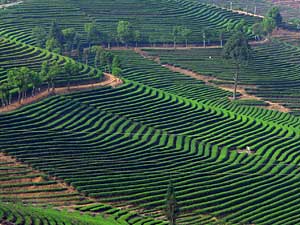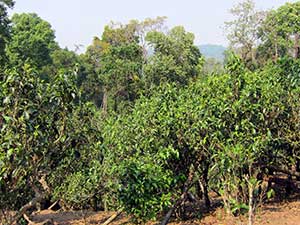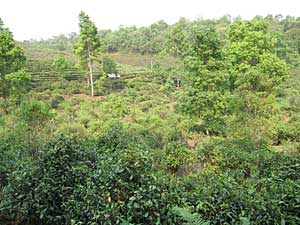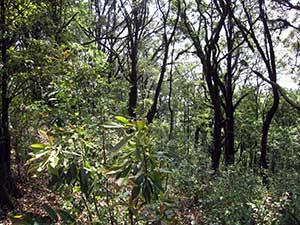
Types of cultivation:
There are four predominant methods of tea cultivation; Plantation style (taidi cha), Ancient Tea Gardens (gushu cha), Sustainable Tea Farms (shengtai cha), and Wild Tea Trees (yeh sheng cha). Pictures and explanations can be seen below.
Plantation farms are usually planted with bush-type tea plants all of the same genetic makeup because they are propagated with cuttings. They do not have a main trunk and the branches are spread out like a fountain. They are typically found in tea plantations and are kept small for easy plucking.
Ancient Tea Gardens, Wild Trees and Sustainable Tea Farms usually have arbor tea trees. Like most trees, arbor tea trees have a main trunk with branches growing from the upper part of the main stem. Arbor tea trees are usualy grown from seed, allowed to mature naturally without pruning, and have developed deep roots. Many tea aficionados favor Pu-erh tea from arbor tree because they believe the infusions made from the leaves of these trees to be richer in flavor and possessed of stronger energy (qi). Wild tea trees can be found in deep forests near border regions. However, it is hard to ascertain whether the wild tea trees are truly wild in the sense that they were grown without human intervention, or they were planted by people generations ago but had since been abandoned. Pu-erh tea made from wild tea trees is reputed to possess complex flavors.

Cultivation methods:
1) Plantation style (taidi cha):
Tea plantations are comprised of cultivated tea bushes planted neatly and densely in plateaus or hillside terraces. The bushes are always kept small and most require fertilizers and pesticides. Plantation bushes can yield large quantities of tea and are thus able to meet the demands of mass production. This is the most common type of Pu-erh tea in today's market.

2) Old-growth or ancient tea gardens (gushu cha):
The old-growth tea gardens are comprised of arbor trees planted through seed selection and grown in higher altitudes among other forest plants. Planted via traditional methods, these trees are grown organically, utilizing resources provided by nature and maintaining the ecological balance. Most of the trees in these tea gardens are hundreds of years old. The old-growth tea trees are limited in their yearly production, but the quality of tea harvested from these trees is thought by tea aficionados to be superior to those of the plantation bushes.
According to Selena Ahmed, Ph.D., who brought samples of leaves from ancient tea trees and terrace bushes back to her lab in the United States for research, she discovered that the leaves from the ancient tea trees had the most anti-oxidants. Dr. Ahmed theorizes that the tea from ancient tea trees “... has to work harder to fend off pests and other herbivores and develops these compounds in response.” To see Dr. Ahmed’s study, please see http://onlinelibrary.wiley.com/doi/10.1111/j.1755-263X.2012.00269.x/abstract

3) Sustainable farming tea (shengtai cha):
This type of cultivation method is aimed at a return to traditional organic farming practices. Tea trees are planted from seeds and are not pruned. They are also properly spaced with fruit trees planted in between to impart fruity flavors and to provide shade for the tea trees. Fertilizers and pesticides are rarely used. These tea trees are generally under 100 years old.

4) Wild tea trees (yeh sheng cha):
The term “wild tea trees” can refer to a number of scenarios and, therefore, can be misleading. By definition, wild tea trees refer to tea trees that are grown naturally and randomly without human intervention. However, many tea experts assert that leaves picked from genuine wild tea trees are not be suitable for drinking. Generally speaking, wild tea trees can refer to tea trees grown several hundred years ago that have been domesticated for human consumption. Some of these tea trees might have been grown wildly and others may have been planted by people but were abandoned for centuries. These trees are generally very large and are found deep in the forests in Yunnan. As these trees have been growing alongside with other forest plants and picking up various scents, teas made from these wild tea trees are more complex and distinct in flavor. The leaves of tea cakes made from wild tea trees are less regular and fine. Sometimes they may even mix with leaves from other plants.
To see a video on the different types of Pu-erh tea cultivation, please click here
Photos by Linda Louie and Angie Lee

